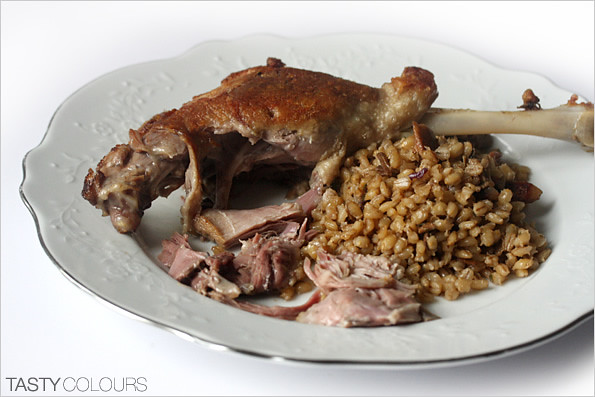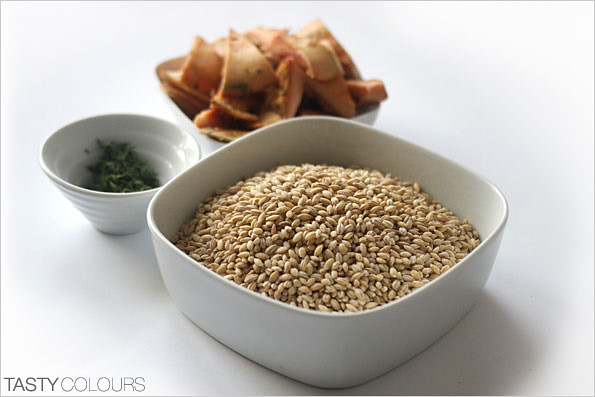November
the 11th is not only Independence
Day in Poland, but it is also Saint
Martin's Day - which has been celebrated in Europe since ages, and came to Poland from France
via Germany. In the past, St. Martin’s Day used to mark the beginning of the
goose season.
Since a few years, we also have here in Poland,
in November, a public event organized, most notably, by Slow Food Polska - “Gęsina na św. Marcina” – which means
“goose tastes best on St. Martin’s fest”.
The event has been advertised in the media, including TV, as well as in the
Polish Parliament. Why? The answer is very simple: goose meat was one of the
most popular ones before the Second World War. After 1945 it disappeared nearly
completely from our tables, like some other meat and fish. Before 1939, every
November, young geese were traditionally killed and eaten for St. Martin’s Day.
Those intelligent birds are nowadays again produced
in Poland (mostly in the north of the country). Poland is the largest European producer
and exporter of goose meat, so one could think that it should be easily
available in the whole country. That is wrong. To find fresh goose meat in
stores is a nightmare. In particular here, in the south of Poland. Moreover, around
90 per cent of all its production is exported
to Germany and other European countries, where it enjoys a very good reputation
for its quality and its taste. I hope that this will change sooner than
later and that Poles will have goose meat in every good grocery store.
Exceptional young Polish oat goose (“polska młoda gęś owsiana”)
is a meaty race of goose which not only
is great in taste but also healthy and rich in omega 3 non saturated acids.
It is named “oat goose” because the birds eat oats before they are killed.
The November goose event (“gęsina na Św. Marcina”) is
supported by the renowned Polish chefs, such as, for example, Wojciech Modest Amaro
(Atelier Amaro, Warszawa), Adam Chrząstowski
(Ancora, Kraków), Karol Okrasa
(Plater, Warszawa)
and many, many others. Between the 9th
and the 25th of November
those chefs invite to their restaurants to taste their authors’ version of
goose dishes. If you are in Poland between the 9th and the 25th
of November, you can visit one of the restaurants participating in the “goose”
event (the complete list – unfortunately in Polish only, is linked HERE).
If, by accident, you visit one of the restaurants in Kraków, feel free to share
your opinion at: magdalena@tastycolours.com.
The geese which are traditionally eaten for St.
Martin Day are young birds, around 1
year old and 4-5 kg in weight. The most popular stuffing for the whole
baked goose in my region is buckwheat and mushroom.
Today I am proposing to you a goose
confit served with “barlotto” mushrooms.
Barley
(pęczak) is the largest cereal grain of the pearl
barley family, easily available in Poland. It is a whole, uncrushed grain of
barley, and it needs a longer cooking than regular pearl barley – you can see
on the picture below, what it looks like.
I must say that this time I am 100 hundred per
cent happy with my confit – since I
decided to cook it slowly in, of course, a big amount of goose grease, but also
in some wine. That prevents the meat from roasting – the problem which I was
facing while preparing rillettes, for
example. My dish was served with red sauerkraut
braised with pumpkin, honey and lemon.
Goose Leg Confit and Pearl Barley – Mushrooms “Risotto”.
Serves 2
Goose Confit:
2 nice goose
legs (around 500 g each)
700 – 800 g goose grease
1 bay
leave
2 cloves
8-10 rosemary
stalks
2 black
pepper grains
600 ml dry white wine (400 ml for the marinade and then for cooking)
Salt
1. Marinade
the goose legs: wash and wipe the legs. Pour around 350 ml of wine over them,
add the bay leave, cloves, rosemary stalks and pepper. Put aside for around 4
hours, flipping occasionally.
2. After
four hours take a large, wide, but not very deep saucepan and melt the goose
grease (over medium heat). Add goose legs with spices and wine.
3. Confit
your legs: cook over minimum heat until tender – in my case, it was around 3
hours. You have to make sure that the legs are always covered with the liquid.
If the grease starts to sizzle despite the fact that the legs cook over low heat,
just add some more wine. This prevents the meat from roasting in the grease and
secure that the meat will remain soft and tender. Check quite often if your goose legs do not start to roast in the grease. I was
using dry white wine, as I did not want to kill the natural taste of goose and
the colour of the goose grease with red wine. Note also that my goose legs were
quite big (over 0.5 kg each) so you have to adjust the cooking time
accordingly.
4. When the meat is soft and tender, remove it from the heat. You can either cool it down and keep the grease, jarred and use when you need it, or pan fry it over low heat, still warm, until the skin is nicely roasted. A lot of recipes call for roasting in the oven, but I believe that the meat remains juicier and the skin crispier, if roasted in a pan (of course, you will have to remove the excess of grease at that point). Salt before serving according to your taste.
Barley “Risotto” (“Pęczotto”)
Serves 2
150 g pearl
barley
100 ml dry
white wine
30 g dried
ceps (appx 700 ml forest mushrooms liquid*)
1 tablespoon, fresh thyme leaves
150 g pine
mushrooms caps, cleaned and cut into quarters
2 tablespoons clarified butter
2 tablespoon goose grease
1 shallot,
peeled and finely chopped
1. Prepare the mushroom broth: Place the mushrooms in a
saucepan and add 750 ml of water. Let them soak for around 1 hour in warm water.
Cook them in the soaking water, under the cover, for 20-30 minutes or until
they are soft. Strain the liquid, put it aside, reserve the ceps and cut them
into stripes. You will need them for “barley” risotto (“barlotto”).
2. Prepare the pine mushrooms: In a hot large frying pan, heat 1 tablespoon of butter, add pine mushrooms, and fry them for about 3-4 minutes, until nicely grilled (depending on the thickness of their caps) and until they release their juices and absorb them back (when frying over high heat, they should not release a lot of juice). Salt and pepper and leave aside.
3. Prepare “barlotto” (pearl barley "risotto"): heat
the mushroom broth and let it simmer over low heat. In a deep pan, fry the shallot in goose grease, until slightly
softened but not browned. Add the barley grains, and fry, stirring until it
starts to turn translucent. Next, add the wine and cook, stirring until wine is
absorbed. Add chopped ceps and thyme. Pour a ladle of hot mushroom stock and
stir. Turn down the heat to a simmer so the pearl barley doesn’t cook too
quickly. Keep adding ladles of stock, and stirring. However, you will not
notice so much creamy starch as when preparing a risotto with rice. This will
take around 30 minutes, until the barley is cooked. Season with salt and pepper,
add the remaining spoon of butter, cover and let it rest for around 2 minutes.
Serve with your goose confit.
Polish Style Braised Red Sauerkraut with Pumpkin
This recipe is inspired by one of the recipes of Polish
young chef Karol Okrasa, who made this cabbage with regular, white sauerkraut
Serves 2
150 g
red sauerkraut (you can replace it by the regular white sauerkraut which
you will find in food stores with Polish food).
100 g pumpkin
(after removing its skin) – cut into thin, 2 cm slices
2 tablespoons good quality flower honey
Juice from ½ lemon
2 tablespoons goose grease
1. In a
frying pan, heat the goose grease, add honey and pumpkin, and sauté it until
slightly transparent. Add red sauerkraut, heat well and braise for a couple of
minutes. Add lemon juice, season with some salt and pepper if necessary.











5 comments:
dziękujemy za dodanie pięknego zdjęcia! :)
Wykrywacz Smau - a dziękuję, a noga gęsia była git :)
Psst... Barley "risotto" is known as "orzotto".
PS. You've got new mail.
Hi there, Szalony Kucharz, are you alive ???
Alive and kicking. Just moved into an apartment last month and finished furnishing the small kitchen that's there. And got a new job in the meanwhile. I should get back to making videos soon, just need to get net connected and invest a few quid in lighting.
Post a Comment